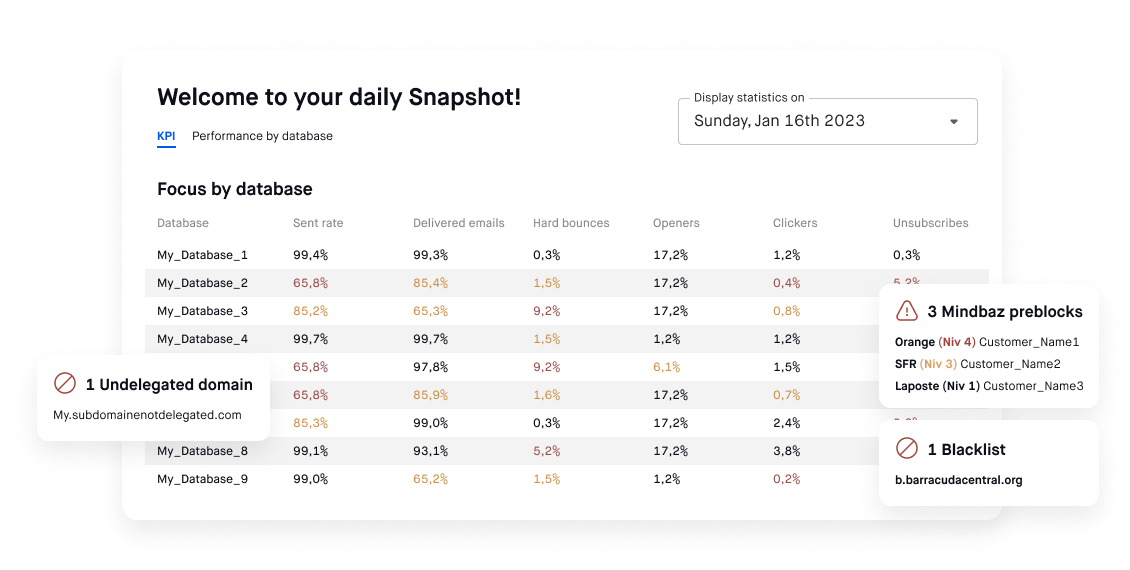Are you frustrated with your email sending solution? You’re not alone. Poor deliverability, absent customer support, outdated features: these issues hinder your marketing campaigns and reduce your efficiency.
However, changing your email sending solution can unlock better engagement with subscribers, simplify your daily tasks, and improve results.
⚡ Learn how to choose the ideal platform and ensure a smooth transition with simple and practical advice.
In brief: 20 key actions to successfully migrate your email solution
Short on time? Here’s a quick summary of 20 actions to ensure a smooth and efficient migration to a new email sending solution:
- Conduct a data audit to analyze active and inactive contacts.
- Verify the quality of data collection to comply with regulations (GDPR) and minimize complaints.
- Prioritize active contacts to quickly build a good reputation.
- Plan a gradual migration to avoid impacting deliverability.
- Warm up new IPs by starting with the most engaged segments.
- Export critical data (bounces, unsubscribes, clicks, opens) from your previous provider.
- Analyze distribution by providers (MSP) to adjust your deliverability strategies.
- Set up integrations with existing tools to streamline workflows.
- Choose a sovereign provider that complies with European regulations.
- Ensure data format compatibility to avoid technical errors.
- Communicate the migration to your subscribers to build trust.
- Secure the transition for new subscribers by integrating them gradually.
- Test data flows between the old and new providers to ensure reliability.
- Use A/B campaigns to optimize content and improve engagement.
- Seek expert guidance to minimize errors and ease the transition.
- Pause lower-quality data collection to minimize risks.
- Personalize campaigns for inactive users to reactivate them.
- Prioritize user engagement by focusing on the most interactive campaigns.
- Track key statistics (open rates, clicks, bounces) to adjust in real time.
- Prepare emergency scenarios to anticipate and resolve potential issues.
Applying these steps ensures a smooth migration and optimizes your performance from the start. 🚀
Step 1: Determine why you should change your email sending solution
Before switching your email sending solution, ask yourself the right questions: does your current platform still meet your needs? Here are the signs that it might be time to consider an alternative.
Signs that you need to change your email sending solution
Your open and click-through rates are declining
Despite your efforts to improve your campaigns, your emails end up in spam or go unnoticed. This could be due to a deliverability issue related to your current solution.
Customer support falls short
Your marketing team loses valuable time waiting for responses or searching for solutions on their own. Responsive support is crucial for handling incidents and optimizing your campaigns.
Your platform lacks modern features
- No advanced personalization?
- Unable to properly segment your lists?
- No A/B testing available?
An outdated platform hinders your creativity and performance.
The tool is too complex or poorly adapted
A difficult-to-use interface slows your team down and leads to errors. You need an intuitive tool to save time.
What you lose by staying with an inadequate solution
Not changing your email sending solution can cost you dearly:
- Decreased deliverability: Fewer emails reach your subscribers.
- Low engagement: Less effective campaigns mean lower ROI.
- Loss of competitiveness: Your competitors adopt modern tools while you remain stuck.
Why switch to a more effective solution?
Switching your email sending solution means:
- Sending high-performing campaigns thanks to better deliverability.
- Simplifying your daily tasks with features tailored to your needs.
- Optimizing your ROI by better engaging your subscribers.
🔔 Ask yourself this key question: Does your current solution allow you to achieve your marketing objectives? If the answer is no, it’s time to make a change.
Step 2: The checklist for successfully changing your email router
1. Assess your emailing needs
Before choosing a new platform, start by analyzing your needs:
- What are your goals? Do you want to improve deliverability, simplify your processes, or integrate new features like automation?
- Which features are essential? Prioritize tools such as:
- Advanced segmentation.
- A/B testing to optimize your campaigns.
- Dynamic content personalization.
💡 Tip: A suitable sending solution should meet your current needs and support your future growth.
2. Compare email marketing software on the market
The comparison phase is crucial. Here are the key criteria for choosing a new email sending solution:
- Deliverability rate: Opt for a platform known for delivering messages to inboxes.
- Ease of use: An intuitive interface allows your teams to work efficiently.
- Responsive customer support: Check response times and the quality of support.
- Possible integrations: Ensure the solution can connect to your existing tools (CRM, e-commerce, etc.).
- Free trial period: Test the solutions before committing.
📢 Advice: Choose a European sovereign solution that complies with regulations like GDPR.
3. Prepare your migration to a new email sending solution
A successful email solution change requires careful preparation. Following these best practices ensures a smooth transition without interrupting your campaigns.
Clean your database to optimize your sends
Before any migration, efficiently managing your contact database is essential:
- Identify your active contacts: Prioritize subscribers who regularly open and click on your messages to build a strong sender reputation.
- Remove inactive or outdated addresses: Eliminate bounced emails or invalid addresses to minimize complaints and improve deliverability.
✅ Example: Use email validation tools to detect incorrect addresses before importing them into your new router.
Check the quality of email address collection
A quality contact list is key to successful mass emailing:
- Ensure your collection methods comply with GDPR: This avoids spam complaints and poor data handling.
- Review your subscription forms: Ensure your subscribers have consented to receive your content.
🔗 Take advantage of the platform change to diversify your email collection methods
Plan IP warming
Switching email routers often involves working with new IP addresses. These need to be “warmed up” to avoid being blocked by email services:
- Start with the most engaged segments: Send emails to your best contacts to establish a strong sender reputation.
- Gradually increase send volumes: Spread sending over several weeks to avoid drawing the attention of spam filters.
💡 Tip: Schedule regular sends of quality content (like a newsletter) to maintain stable activity during the ramp-up period.
Test the new platform
To avoid surprises, test with a sample of your contact database:
- Run a pilot campaign: Test your templates, links, and authentication processes (SPF, DKIM, DMARC).
- Analyze the results: Monitor open rates, clicks, and bounces to identify necessary adjustments before the full switch.
✅ Example: Also test performance across different email providers like Gmail or Yahoo to check format compatibility.
Inform your subscribers about the change
Notifying your audience can build trust and improve engagement:
- Send a clear message: Explain that you are switching platforms to improve the quality and relevance of your emails.
- Reassure your subscribers: Let them know their data and experience will be better handled thanks to this transition.
💡 Tip: Include this information in a newsletter or dedicated email to effectively inform your contact list.
Train your team using the new platform’s support
The success of your migration also depends on your team:
- Schedule training sessions: Familiarize your team with the new interface and its features.
- Establish clear procedures: Document best practices to avoid common mistakes.
Are you feeling lost in your decision to change your email sending solution?
🔗 Contact our team
4. Monitor your email performance after the migration
Once the transition is complete, keep an eye on your metrics to evaluate the impact:
- Open and click rates: Are they improving?
- Bounce rate: Is it decreasing?
- Conversion rate: Are your campaigns generating more results?
If performance declines, adjust your strategies based on the available data.
Step 3: Choose the best email solution using 5 criteria
Here are the key criteria to verify to ensure you select a platform that meets your needs.
1. Excellent deliverability: your emails reach their target
Your priority should be sending newsletters that land in the inbox, not in spam. A good solution:
- Offers tools to monitor your deliverability rates.
- Provides dedicated or well-warmed shared IPs.
- Relies on a robust infrastructure to avoid blockages.
2. Ease of use to save time
Your tool should be an ally, not an obstacle. Look for an interface that is:
- Intuitive, even for non-technical users.
- Easy to learn with accessible guides or tutorials.
- Allows you to create campaigns in just a few clicks, without frustration.
3. Modern features to boost your campaigns
The market evolves, and your solution must keep up. Make sure it offers:
- Advanced personalization options to engage your subscribers.
- A/B testing to identify what works best with your audience.
- Email automation to manage complex scenarios (welcome, cart recovery, etc.).
- Features to ensure your emails land in the inbox
4. Responsive customer support to avoid being stuck
Good customer support makes all the difference in case of issues. Choose a solution that offers:
- Responsive customer service.
- Support in your language, such as French.
- Short response times, even for small teams.
- Turnkey solutions for your challenges.
5. Seamless integrations with your existing tools
Your platform should integrate with your current ecosystem to enhance efficiency. Check compatibility with:
- An efficient email builder (Stripo, Mediego…)
- Your CRM (HubSpot, Salesforce, etc.).
- Your data analysis tools (Google Analytics, etc.).
- An API for brands with in-house tools…
Mindbaz is the email solution that prioritizes effective support: Quick responses, personalized developments, and dedicated interconnections for marketing professionals…
🔗 Discover the French email sending platform optimized for your deliverability
| Criteria | Why is it important? | What to check |
|---|---|---|
| 📧 Deliverability | Your emails must reach the inbox. | Deliverability rate, IP quality, technical infrastructure. |
| ✨ Ease of use | Save time on campaign creation and management. | Intuitive interface, ease of use. |
| 🚀 Modern features | Optimize your campaigns for better ROI. | Automation, personalization, A/B testing. |
| 🤝 Responsive customer support | Stay operational even in case of issues. | Chat, support in your language, short response times. |
| 🔗 Integrations | Work efficiently with your existing tools. | Compatibility with CRM, e-commerce, analytics tools. |
Step 4: Have you chosen your new email sending solution? Excellent!
Steps for a successful transition to your new email platform
A successful migration requires good organization. Quickly get in touch with the solution’s team, and then follow this practical timeline with concrete tips for each step.
Timeline for switching email routers in 4 weeks
- Clean the database.
- Export data.
- Team briefing.
- Configure interconnections.
- Import data.
- Set up IPs and domains.
- Run test emails.
- Analyze performance.
- Adjust configurations if necessary.
- Plan the full migration.
- Monitor results in real-time.
- Prepare a final report.
Cliquez sur chaque ligne pour voir les actions par semaine
Tips to avoid common pitfalls during migration
- Don’t migrate everything at once. A gradual transfer minimizes risks.
- Document the entire process. This makes adjustments easier in case of issues.
- Collaborate with customer support. If you encounter an obstacle, reach out to them promptly.
By following this timeline, you’ll ensure a smooth migration and minimize the risk of disruptions in your campaigns. Your new solution is ready to bring out the best in your newsletters and emails! 🚀
Ready? Switch!


